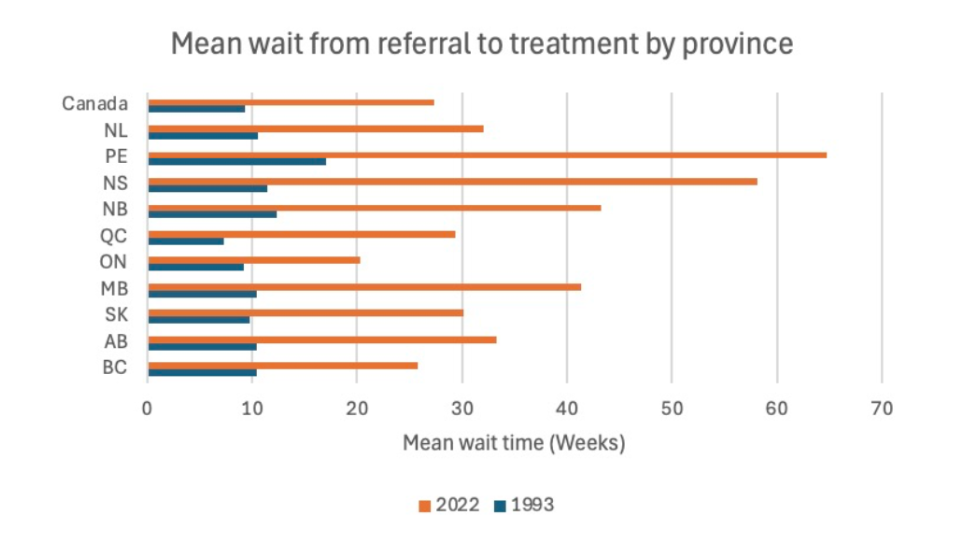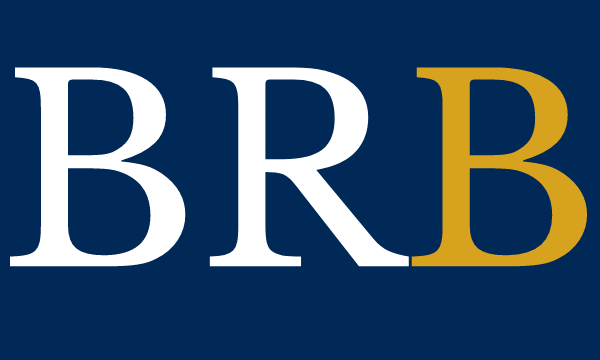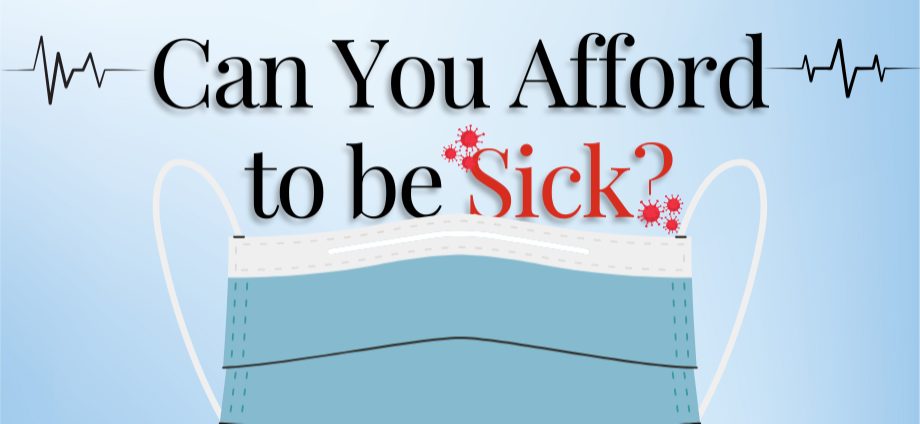Author: Isaac Oommen | Graphics: Business Review at Berkeley | Publishing: Simona Itkin
When the cost of care leads to despair, look to Canada for a system that’s fair.
Introduction
The United States has one of the most expensive healthcare systems in the world. Healthcare costs have increased from 5% of the United States GDP in 1962 to 17% in 2022. While this significant boost may lead you to believe that the quality of healthcare has increased with the rate of spending, US healthcare routinely ranks last compared to other developed countries in factors including equity, quality, and efficiency. The cost of healthcare has become a burden for taxpayers because high out-of-pocket costs can often lead to debt, deterring Americans from seeking healthcare, even in vital situations.

(US in Red, Canada in Yellow)
What makes US healthcare so expensive? Our neighbor in the north may serve some answers. While Canada and the US share similar backgrounds in culture, language, and economies, Canada’s universal healthcare system cuts healthcare prices in half compared to the US, and still outperforms the US in life expectancy and overall health.
United States Healthcare System
How the System Works
The United States healthcare system consists of both public and private providers. The primary form of healthcare coverage in America comes from private, employer-based insurance. While private insurance lowers the cost of your bills, co-pays (fixed fees) and deductibles (the amounts billed before insurance starts covering costs) can still lead to significant out-of-pocket costs.
The second largest method of healthcare coverage is Medicare, a federal government-funded program that provides coverage for adults over 65 or those with disabilities. While the Medicare program is an important step for making healthcare accessible, the eligibility does not cover the majority of Americans seeking healthcare.
Each state also manages its own Medicaid program, which provides coverage for low-income individuals and families. To be eligible for Medicaid in California, you must be over 65, under 21, have a disability, or be pregnant. Once again, these eligibility requirements leave out a vast majority of Americans who desire accessible quality healthcare.
Cost of US Healthcare
Compared to Canada, healthcare costs in the United States place a significant burden on citizens, especially due to out-of-pocket expenses such as insurance premiums, co-pays, and deductibles. For example, an MRI scan costs an average of $1,325, and a general check-up can reach nearly $400. These expenses deter Americans from seeking medical care, even in cases where it is necessary.
In 2007, 12-year-old Demonte Driver was killed due to a meningitis infection that spread to his brain. Had his family had insurance, an $80 tooth extraction would have saved his life. This extreme case exemplifies the experience of many Americans who had avoided care due to the high cost of insurance and out-of-pocket care. Despite qualifying for Medicaid, Demonte’s family was unable to find a dentist in Maryland who accepted Medicaid parents. His death highlighted that the inaccessibility and high costs of healthcare can have a human cost.

A 2022 Kaiser study found that one in four adults avoided healthcare due to costs, a problem that affects underserved communities, including racial minorities, women, low-income individuals, and uninsured adults. Insured Americans are not immune to this hardship, as 48% of insured adults worry about their ability to afford monthly premiums.
Canada’s Healthcare System
In contrast, Canadian Medicare is Canada’s universal healthcare system that is publicly funded by Canada’s 13 provinces and territories. A universal healthcare system ensures that all residents of a country have access to quality healthcare regardless of their age or financial status. Canada’s system provides residents with all medically necessary care for free. Provinces also provide partial coverage for extended services, such as prescription drugs and dental, and the rest is often covered by private insurance.
The Canadian Institute for Health Information reports that 70% of healthcare costs in Canada are covered by public funding, while the remaining 30% is paid for by private insurance. The US Census Bureau reports significantly less public funding, with 65.6% of healthcare costs funded privately, whereas public coverage was only 36.1%.
Comparison
Canada spends 10.4% of its GDP on healthcare, which is significantly less than America’s 16%. Despite lower spending, Canadian healthcare continues to outperform the quality of US healthcare. The life expectancy in Canada is around 79.7 years, as opposed to 77.2 years for Americans. Canadians and Americans share borders and indulge in a similar quality of life, which begs the question: why is Canada’s healthcare both cheaper and higher quality?
Simply put, it’s because Canada’s healthcare focuses on people rather than profit. Private healthcare for necessary procedures is illegal in Canada. This system gives hospitals and physicians an incentive to treat everyone with the same quality care, and Canadian citizens have no holdbacks when it comes to whether or not they should access care.
Healthcare accessibility is heavily related to socioeconomic status. A National Institute of Health study found that high income and highly educated people had similar healthcare utilization rates in the US and Canada. In some cases, the US even had higher utilization. However, when it comes to the less educated and lower-class individuals, they were significantly more likely to use Canadian healthcare services in comparison to American citizens. This difference is exacerbated by the fact that America has a higher poverty rate than Canada (11.5% vs 9.9% in 2022).
These differences can be attributed to the general higher cost of healthcare in America. While every Canadian is guaranteed free medically necessary healthcare, American citizens are forced to take on private insurance or take government plans, which are inaccessible. This has led 7% of Americans to be uninsured, making the cost of healthcare for them borderline unaffordable. The extreme cost and inaccessibility for affordable healthcare leads lower class Americans to skip hospital visits, even in severe circumstances.
Although Canada does not publicly fund prescription drugs, Canadians still spend remarkably less on medicine overall. In 2018, the United States spent a record $28 billion on insulin, while Canada only spent $484 million. The 2022 Inflation Reduction Act capped insulin prices at $35, indicating a potential improvement within the US, but the difference in spending reflects a broader issue in American drug pricing. Canada is able to keep significantly lower costs because of its policies controlling pharmaceutical prices, as well as the Competition Bureau’s work in enforcing competition within the pharmaceutical industry.
America could learn from Canada’s system while maintaining the current format by capping the prices of medical procedures in both public and private healthcare. The government may also subsidize the cost of medical equipment to alleviate some of the high costs of patient care and running a hospital.
However, what Canadians gain in healthcare quality, they lack in accessibility. The median wait time between referral and healthcare treatment has been on a steady rise since 1993, reaching 27.4 weeks in 2023 — over 6 months. These exorbitant wait times have led some Canadian provinces to send their patients across the border, one British Columbian saying that Canadian wait times could have cost her life. Free, high-quality care comes with overwhelmed emergency rooms and family doctors, overworked healthcare professionals, and reduced access to specialized care.

While Canada’s universal healthcare system provides access to all of its citizens, the restriction on private healthcare stifles innovation. The United States healthcare system provides one benefit: competition. The presence of private healthcare providers prompts competition in the healthcare industry as companies are incentivized to produce new technologies and improve patient experience. While both systems have their drawbacks, it is clear that the US has a lot to learn from the Canadian healthcare system.
Take-Home Points
- The US healthcare system relies on private insurance and public programs like Medicare and Medicaid, leaving everyday Americans with high out-of-pocket costs and limited access to healthcare.
- Canadian Medicare provides medically necessary care to residents at no cost.
- Despite lower spending on healthcare, Canada has routinely shown better quality healthcare than the US.
- Initiatives like the Inflation Reduction Act under Biden have been created to alleviate the high costs of prescription drugs in America.
- Canadian healthcare lacks the accessibility of the US system, with some Canadians seeing wait times over 6 months.
- Private providers in the US incentivizes innovation in technology and patient experience.

